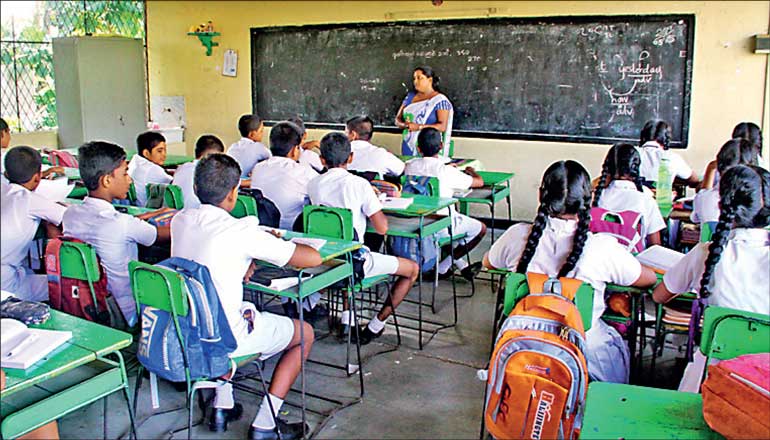Saturday Oct 18, 2025
Saturday Oct 18, 2025
Friday, 17 October 2025 00:25 - - {{hitsCtrl.values.hits}}

Revenue increases should be used to increase social spending, including a goal of moving education spending towards4 to 6% of GDP
 In November 2024, Sri Lanka’s Supreme Court issued an unusual ruling: senior Government officials had breached the public trust by drastically cutting taxes in 2019, setting off a “domino effect” that ended in economic collapse in 2022. The Government’s debt default led to a sharp increase in prices, especially for food and transportation, as well as job and wage cuts, the effects of which are still ongoing.
In November 2024, Sri Lanka’s Supreme Court issued an unusual ruling: senior Government officials had breached the public trust by drastically cutting taxes in 2019, setting off a “domino effect” that ended in economic collapse in 2022. The Government’s debt default led to a sharp increase in prices, especially for food and transportation, as well as job and wage cuts, the effects of which are still ongoing.
Protests that overthrew Gotabaya Rajapaksa’s government, and subsequent elections that brought Anura Disanayake to power, make clear that Sri Lankans are determined to set a new economic course. The Government has already taken some steps, but the reforms aren’t deep enough to get at the root of the problem.
The Supreme Court case was focused on the immediate lead up to the crisis, but we found that the root of the problem goes back decades. In the late 1970s, Sri Lanka began an economic shift including tax policies that generated woefully low revenues, and favoured corporations and the wealthy.
This not only sowed the seeds of the 2022 crisis but also meant Government spending that is essential to human rights has lagged far behind growth for decades. By the 2010s, for example, Sri Lanka’s education spending was under 2% of GDP, before falling in 2022 to just 1.5%—the third-lowest rate in the world.
That was a tragic decline for a country that was once a global pioneer in education. Sri Lanka was among the first countries to establish free primary and secondary education for most people. Following independence, government funding of education—particularly in rural areas—lifted literacy and attendance rates to far outpace peer countries, helped spur social and economic mobility, and reduced inequality.
Taxes underpinned these achievements. Government revenues—around 90% from taxes—ranged between 20 and 25% of GDP in the 1960s and 70s. This enabled public education spending of 3 to 5%, close to the broadly accepted target of 4 to 6% to make progress on the right to education.
But a 1977 shift in economic policy toward an approach that gained dominance at the time that promoted growth as its own end, resulted in a sharp decline in tax revenue. The Government began handing out broad and opaque corporate tax exemptions ostensibly to attract investment, despite dubious evidence of their effectiveness. It also made little effort to tax the income or assets of people benefiting from the country’s growth. In the decade prior to the 2019 tax cuts, Sri Lanka’s tax-to-GDP averaged around 10%, less than half what it had been in the past.
The resulting low revenues have translated into inadequate school budgets that squandered Sri Lanka’s early achievements in education. Today, many schools rely on fees or alumni support for things as basic as exam paper and building maintenance.
A teacher in a public school in Colombo said her school had a science lab and smart boards thanks to the old boys club, while an Ampara official said there weren’t enough chairs for students in many of his schools. World Bank and academic research has shown widening disparities based on students’ socio-economic backgrounds, with lower enrolment in poorer areas.
Concerns about the quality of education resulting from decades of underfunding have been driving a proliferation of after school tuition classes to such a degree that experts now describe them as a “shadow education” system.
A domestic worker living on a tea plantation in Hatton said she earns around Rs. 14,000 monthly working seven days a week and struggles to pay Rs. 5,000 every month for both of her children to attend tuition classes, in addition to the Rs. 500 the school charges in various fees every month. “When teachers ask for books and papers I can’t get those things,” she said. “I struggle to give nutritious food to my children.”
A woman in Batticaloa put it stark terms: “I have difficulty sending [my daughter] to school every day because I don’t earn enough money… I need to choose between food and my daughter’s education.”
To uphold the economic and social rights of Sri Lankans, including to education, the Government should institute tax reforms to increase revenues through progressive measures and curtail regressive taxes, including by increasing tax revenues from personal income and wealth.
It should also end corporate tax incentives that are not tied to a specific and compelling policy rationale and subject to public cost-benefit analysis. Revenue increases should be used to increase social spending, including a goal of moving education spending towards 4 to 6% of GDP.
The new Government, which promised to break from past corruption and failed economic policies, has an opportunity to reverse Sri Lanka’s decades-long neglect of tax revenues and under-spending in social sectors, which culminated in misery and crisis. The time is ripe for an economic approach centred on human rights.
(The writer is a senior economic justice researcher at Human Rights Watch and author of a new report about the Impact of Sri Lanka’s tax policies on its public education system.)